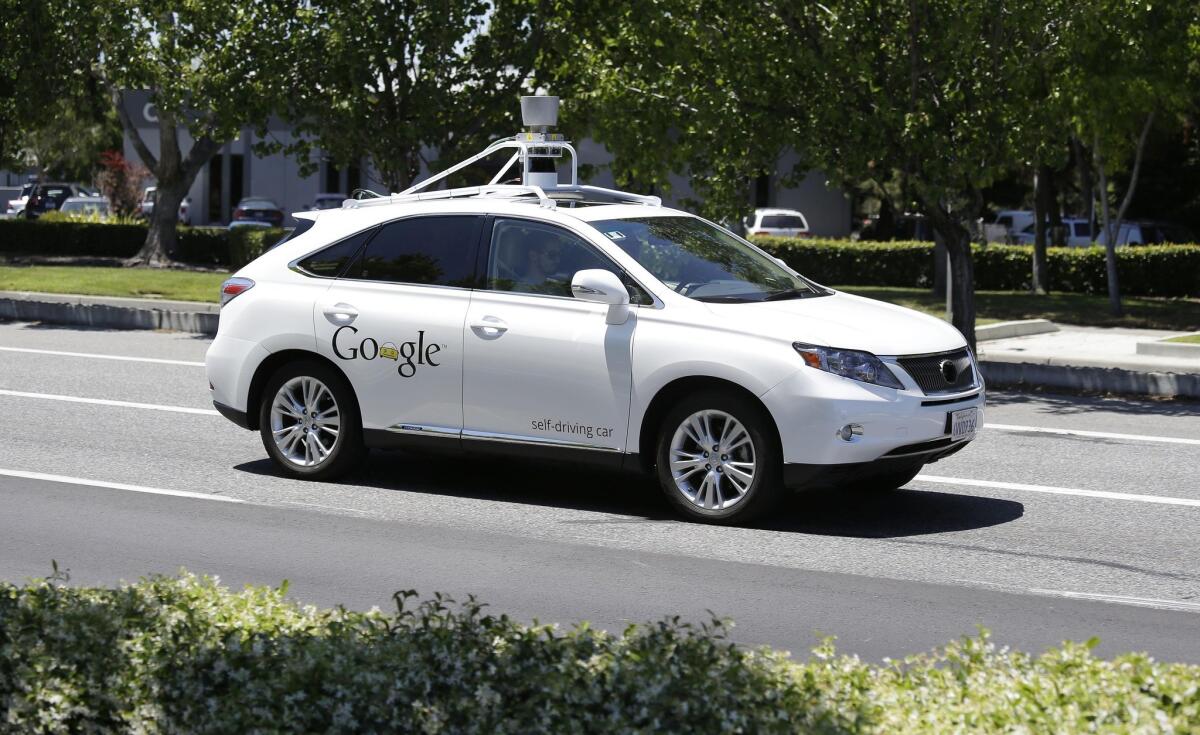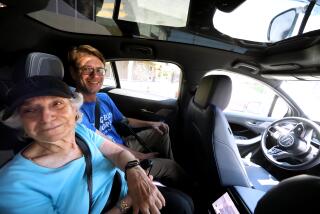Opinion: Stopping self-driving cars before they get out of the showroom

Google self-driving car goes on a test drive near the Computer History Museum in Mountain View, Calif.
Who doesn’t love the idea of self-driving cars?
The California Department of Motor Vehicles, evidently. And The Times editorial board.
Yes, I know, I’m a member of said board, but we play by simple majority rules. And I lost the argument over today’s piece, which praises the DMV for proposing rules that make it pointless (for now, at least) to buy an autonomous car.
Not that anyone will be allowed to buy such a car in this state. Instead, the rules require manufacturers to lease them, meaning that the manufacturers will retain ownership. That stricture lays the groundwork for a second requirement: that manufacturers monitor the cars continually so they can submit monthly performance reports to the state.
Given those mandates, it’s clear the state considers the first deployment of consumer “autonomautos” (yes, I just made up that word) to be little more than an extension of the tests that Google and other manufacturers have been conducting with their own personnel. And that’s not unreasonable -- self-driving cars are a new and potentially disruptive technology.
The problem is that the state goes considerably further in restricting the use of autonomautos. It requires a licensed driver to be at the controls of a self-driving car at all times, paying as much attention to its operation as if he or she were driving a conventional vehicle.
Join the conversation on Facebook >>
That eliminates the most compelling reason for paying what’s likely to be a hefty premium for a driverless car: the ability to get other stuff done while you’re going (or in L.A.’s case, crawling) from point A to point B. Like, say, work. Or reading, catching up with friends, or just enjoying the scenery.
Oh sure, autonomautos will be less likely to cause an accident, so there’s a safety motive for having one. Theoretically, they should also be better at avoiding the vehicles operated by drunk, inattentive or reckless humans. But there are far cheaper ways to find a safer ride than to invest in a robot-controlled car.
The fewer people motivated to pony up for an autonomauto, the less data the state will gather about the vehicles’ safety, and the more protracted the transition will be. Why is that in anybody’s interest?
Think about this for a moment. Autonomautos are just like conventional cars in every respect but one: they replace the distracted and error-prone human operator with technology that has an unlimited attention span, processes data faster than humanly possible and is not allowed to violate traffic laws.
This is an obvious upgrade, at least conceptually. The only real question is whether the software and sensors are up to the demands of real-world driving. And the best way to find that out is to test the cars in real-world situations, with ordinary people using them the way they were meant to be used.
NEWSLETTER: Get the day’s top headlines from Times Editor Davan Maharaj >>
That’s what the manufacturers have been doing, minus the ordinary people; in fact, they moved from closed test tracks to the public streets some time ago. What the DMV should have done is examined the test data and decided whether it had enough proof to allow the cars to be operated as intended by regular consumers, not the manufacturers’ employees. And if it did, it should have given the green light to truly driverless cars, not self-driving cars with a driver at the steering wheel, the gas pedal and the brakes. To calm their own nerves, they could have started by allowing a relatively small number of leases, then worked their way up over time.
The main argument on the other side is that these things could kill people. What, conventional cars aren’t lethal? If anything, autonomautos should be safer for drivers and dramatically better for the pedestrians and cyclists around them.
But what about software glitches? Malicious hackers? Again, conventional cars face many of the same problems -- more and more of a car’s crucial functions are being taken over by software, and the industry failed to design its products with security in mind. And besides, if a self-driving car is vulnerable to calamitous problems, the DMV shouldn’t allow it on the road, period. That’s why it makes sense to have an independent review of a self-driving car’s safety before it can be offered to the public, as the state has proposed.
Manufacturers who negligently put defective products into commerce are strictly liable for the damages they cause. That liability gives car manufacturers a powerful incentive to take a belt-and-suspenders approach to the self-driving features of their cars, with redundancies and fail-safe mechanisms, and to test the living daylights out of them before bringing them to market.
But here in California, lawmakers and government agencies often want to put rules in place to prevent the problems they can imagine, rather than responding to the ones that actually emerge. In doing so, they may also prevent companies from innovating their way to products that serve the public better. Or in this case, make the roads safer.
Follow Healey’s intermittent Twitter feed: @jcahealey
MORE FROM OPINION
Not much love for the ‘freedom agenda’ at GOP debate
FAA to states: Back off and leave drone regulation to us
How we can use data to prevent cycling deaths in Los Angeles
More to Read
A cure for the common opinion
Get thought-provoking perspectives with our weekly newsletter.
You may occasionally receive promotional content from the Los Angeles Times.











